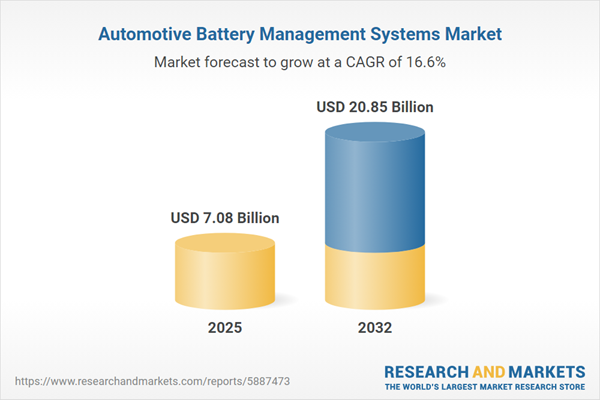Speak directly to the analyst to clarify any post sales queries you may have.
The automotive battery management systems market is evolving rapidly, driven by innovations in electrification, strict regulatory compliance, and increasing demand for efficient powertrain solutions. As next-generation electric vehicles become mainstream, robust battery management is essential for manufacturers seeking operational reliability, performance, and integration across complex automotive networks.
Market Snapshot: Automotive Battery Management Systems Market Overview
The Automotive Battery Management Systems Market grew from USD 6.10 billion in 2024 to USD 7.08 billion in 2025 and is forecasted to continue expanding at a CAGR of 16.58%, reaching USD 20.85 billion by 2032. This growth is propelled by advancements in smart vehicle propulsion, stringent safety mandates, and rising adoption of electric vehicles in both passenger and commercial segments globally.
Scope & Segmentation
- Component Types: Hardware elements include battery management units, battery pack controllers, and cell monitoring units. Software components cover diagnostics and monitoring software, while service providers focus on consulting and integration.
- Battery Chemistries: Segmentation spans lead-acid, lithium-ion, and nickel-metal hydride technologies, each influencing system requirements and safety protocols.
- System Architectures: Centralized, distributed, and modular formats define control strategies and integration pathways for BMS deployment.
- Sales Channels: Market routes comprise both aftermarket solutions and original equipment manufacturer partnerships for seamless integration in new vehicle models.
- Vehicle Types: Diverse BMS applications cater to both commercial vehicles—emphasizing uptime and durability—and passenger vehicles, which prioritize range, cost, and user experience.
- Regions Covered: Americas (including North and Latin America), Europe, Middle East & Africa, and Asia-Pacific — each region contributing unique regulatory, demand, and supply chain dynamics.
- Key Players Analyzed: Leading manufacturers such as Analog Devices, Continental AG, AVL group, BYD Company, CATL, Eberspächer, Ficosa, Hitachi Automotive, Infineon, Leclanché, LG Energy, Microchip Technology, NXP Semiconductors, ON Semiconductor, Panasonic, Renesas, Bosch, ROHM, Samsung SDI, Sensata, STMicroelectronics, Tesla Motors Club, Texas Instruments, and Valeo Service are examined for their strategies, alliances, and innovation investments.
Key Takeaways: Strategic Insights for Decision-Makers
- The automotive battery management systems market is shaped by the integration of advanced sensor networks, predictive analytics, and AI-driven diagnostics that offer real-time visibility and proactive maintenance capabilities across fleets.
- OEMs and BMS providers are deepening collaboration, from consulting and integration to co-development, facilitating tailored system deployment and optimization aligned with regional regulatory benchmarks.
- Modular architectures and open-standard protocols are increasingly central, enabling rapid adaptation to emerging battery chemistries, vehicle types, and evolving software landscapes.
- Supply chain resilience is enhanced through geographic diversification, vendor expansion, and use of long-term offtake agreements—critical under volatile geopolitical and trade environments.
- Technological investments focus on cybersecurity measures to secure vehicle networks and data, and on scalable software updates for constantly evolving requirements throughout product lifecycles.
Tariff Impact: Navigating Policy and Cost Pressures
U.S. tariff policies scheduled for 2025 introduce challenges in BMS supply chains, notably for components and raw materials. OEMs are responding by adopting near-shoring strategies, diversifying vendors, and negotiating advance pricing arrangements, which fosters closer supplier relationships and co-development initiatives while mitigating exposure to trade volatility.
Methodology & Data Sources
This research integrates primary interviews with executives from OEMs, technology providers, and battery manufacturers, with rigorous analysis of secondary sources such as technical publications, regulatory documents, and supplier disclosures. Multiple validation cycles and data triangulation enhance credibility of findings and trend interpretations.
Why This Report Matters
- Equips senior leaders with actionable insights into rapidly changing market and technology environments.
- Supports strategic product planning and investment decisions by revealing segmentation, innovation trends, and regional differences.
- Facilitates risk mitigation through analysis of regulatory and supply chain disruptions, including tariff impacts.
Conclusion
Staying ahead in the automotive battery management systems space requires strategic focus on technology integration, agile supply chain practices, and alignment with global policy developments. This report serves as an essential tool for decision-makers navigating this dynamic market.
Additional Product Information:
- Purchase of this report includes 1 year online access with quarterly updates.
- This report can be updated on request. Please contact our Customer Experience team using the Ask a Question widget on our website.
Table of Contents
3. Executive Summary
4. Market Overview
7. Cumulative Impact of Artificial Intelligence 2025
Companies Mentioned
The companies profiled in this Automotive Battery Management Systems market report include:- Analog Devices, Inc.
- Continental AG
- AVL group
- BYD Company Ltd
- Contemporary Amperex Technology Co.
- Eberspächer Gruppe GmbH & Co. KG
- Ficosa Internacional SA
- Hitachi Automotive Systems
- Infineon Technologies AG
- Leclanché SA
- LG Energy Solution Ltd.
- Microchip Technology Incorporated
- NXP Semiconductors N.V.
- ON Semiconductor Corporation
- Panasonic Corporation
- Renesas Electronics Corporation
- Robert Bosch GmbH.
- ROHM Co., Ltd.
- SAMSUNG SDI Co., Ltd.
- Sensata Technologies, Inc.
- STMicroelectronics N.V.
- Tesla Motors Club LLC.
- Texas Instruments Incorporated
- Valeo Service SAS
Table Information
| Report Attribute | Details |
|---|---|
| No. of Pages | 190 |
| Published | November 2025 |
| Forecast Period | 2025 - 2032 |
| Estimated Market Value ( USD | $ 7.08 Billion |
| Forecasted Market Value ( USD | $ 20.85 Billion |
| Compound Annual Growth Rate | 16.5% |
| Regions Covered | Global |
| No. of Companies Mentioned | 25 |









